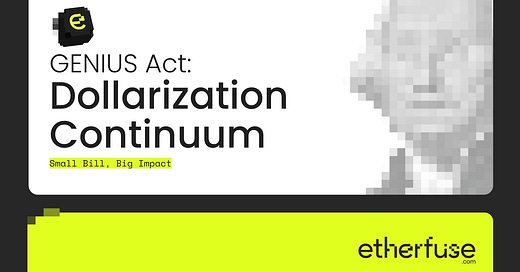My previous piece, Dangers of Digital Dollarization, outlined how stablecoins function as a soft extension of US monetary power. Most are pegged to the US Dollar, move easily across borders, and serve as a store of value in countries where local currencies can't hold. It wasn't regulated, but it was happening.
The GENIUS Act doesn't spark a transformation. It legitimizes what is already underway.
Grey Area to Green Light
The bill has passed through the Senate and is now on its way to the House. If signed into law, it would shift some stablecoins from a regulatory grey zone into a federally defined system. The relatively short bill outlines who can issue them, how reserves must be backed, and what technical standards must be met.
Many see this legislation as a long-overdue set of standards, but this goes beyond the regulatory framework. It accelerates the adoption of stablecoins and legitimizes GENIUS-compliant assets as part of US monetary strategy.
The Dollarization Continuum
In physics, a continuum moves without clear boundaries, in slow shifts rather than sudden leaps. Dollarization mirrors this model:
What began as physical cash has quietly evolved into stablecoins that now move US dollar value across borders. The shifts are gradual, but the underlying structure is changing.
Laying a Global Framework?
The US financial system often sets the tone for global economic policies. The GENIUS Act could quietly set an international standard.
If the US formally recognizes stablecoins through this bill, other countries may feel pressure to follow suit, either by accepting these tokens in their markets or by building a parallel framework.
This opens the door to two outcomes: broader recognition of stablecoins as a sanctioned currency or, more likely, a deepened global dependency on US economic infrastructure.
The Problem is Two-Fold
While regulation is beneficial, this bill has two high barriers: who can issue stablecoins and how they must back their tokens.
Issuer Restrictions
GENIUS narrows the field by limiting issuance to:
FDIC-insured banks and their affiliates
Nonbanks with a special federal charter
State-regulated firms with < $10B in assets
This list overwhelmingly favors institutions that are already embedded in the US financial system. Crypto-natives, developers, and international projects are effectively excluded from recognition under this framework.
Instead of promoting competition, the act consolidates control amongst a handful of existing institutional players.
Backing Restrictions
GENIUS-compliant stablecoins must be backed by:
US cash
FDIC-insured deposits
Central bank reserves
Short-term US Treasuries (93 days or less)
There is no room for sovereign debt from other nations, crypto collateral, or diversified reserve systems. These assets aren't just pegged to the Dollar; they are private tokenized wrappers of public debt.
This ensures perceived stability but also embeds US infrastructure into every system in which the tokens circulate.
Guidelines or Gatekeeping
The GENIUS framework goes beyond compliance. It introduces technical standards to facilitate interactions across apps, wallets, chains, and payment systems.
These guardrails enable the scale of stablecoins, giving large issuers the foundation to operate across both decentralized and traditional platforms. While increasing usability, they also raise entry barriers, further entrenching institutions that can easily meet those standards and isolating smaller innovators.
Macroeconomic View
Concerns about dollarization aren’t new, but this framework introduces a deeper layer. These aren't just physical dollars entering a local economy. They're tokenized, Treasury-backed assets that can move instantly across markets.
GENIUS bypasses coordination and enters global systems through infrastructure, not diplomacy. It reshapes the kind of money people trust, how governments control capital, and how monetary power is distributed. This isn't market-driven dollarization; it's structured monetary expansion.
GENIUS is Good (for the US)
From a domestic perspective, the bill makes perfect sense. It standardizes a growing sector, reinforces demand for Treasuries, and builds new monetary infrastructure, all without the Central Bank.
But globally, the consequences are less clear and potentially more disruptive.
GENIUS doesn't just regulate the stablecoin, it legitimizes and extends US economic influence in a way that favors private actors aligned with American interests. Other frameworks excluded. Other currencies sidelined.
Whether this stabilizes or reshapes global framework remains to be seen. But one thing is clear: the US is taking the lead in defining the future of currency.





